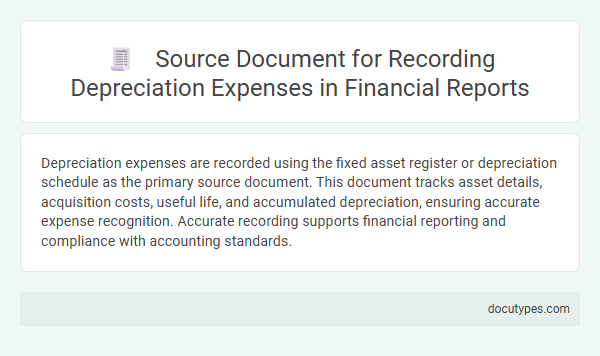Depreciation expenses are recorded using the fixed asset register or depreciation schedule as the primary source document. This document tracks asset details, acquisition costs, useful life, and accumulated depreciation, ensuring accurate expense recognition. Accurate recording supports financial reporting and compliance with accounting standards.
Introduction to Depreciation and Source Documents
Depreciation refers to the systematic allocation of the cost of a tangible asset over its useful life. Accurate recording of depreciation expenses is essential for reflecting asset value and expenses in financial statements. The primary source document used for this purpose is the depreciation schedule or asset register, which details the asset's cost, useful life, and accumulated depreciation.
Importance of Accurate Depreciation Recording
The source document commonly used for recording depreciation expenses is the fixed asset register or depreciation schedule. This document details the asset's purchase date, cost, useful life, and accumulated depreciation.
Accurate recording of depreciation expenses ensures proper matching of asset costs with revenue over time. It enhances financial statement reliability and supports compliance with accounting standards.
Common Source Documents Used for Depreciation
| Source Document | Description | Purpose in Recording Depreciation |
|---|---|---|
| Fixed Asset Register | A detailed record of all fixed assets owned by a company, including purchase date, cost, useful life, and accumulated depreciation. | Serves as the primary reference for calculating and tracking depreciation expenses accurately over asset lifespan. |
| Depreciation Schedule | A document outlining the depreciation method, rate, and periodic depreciation amount for each asset. | Used to systematically record depreciation expenses in accounting records for precise financial reporting. |
| Purchase Invoice | Official proof of asset acquisition cost and date from the supplier or vendor. | Helps establish the initial cost basis for depreciation calculations and verification of asset value. |
| Journal Voucher | A document authorizing and detailing the depreciation expense entry in the accounting system. | Acts as evidence for recording depreciation expense transactions in the general ledger. |
| Asset Disposal Report | Records details when assets are sold, scrapped, or otherwise disposed of. | Ensures depreciation expense is adjusted and asset removal is properly documented in accounting records. |
Your accurate record-keeping of these source documents is essential for reliable depreciation expense reporting and compliance with accounting standards.
Key Information Captured in Depreciation Documentation
Depreciation expenses are recorded using the fixed asset register as the primary source document. This document provides detailed information about the assets, including acquisition dates, cost, and estimated useful life.
Key information captured in depreciation documentation includes the asset's original cost, accumulated depreciation, and the method of depreciation applied. Your accurate maintenance of these records ensures precise financial reporting and audit compliance.
Role of Asset Registers in Depreciation Reporting
Source documents for recording depreciation expenses typically include asset registers, which provide detailed records of each asset's cost, acquisition date, and useful life. Asset registers play a crucial role in depreciation reporting by ensuring accurate calculation and systematic tracking of depreciation over time. You rely on these registers to maintain transparency and compliance in financial statements related to asset management.
Methods for Calculating Depreciation Expenses
What source document is used for recording depreciation expenses? The primary source document is the fixed asset register, which details each asset's cost, acquisition date, and useful life. Recording depreciation expenses requires accurate data from this document to apply the chosen calculation method effectively.
Which methods are commonly used for calculating depreciation expenses? The straight-line method and the declining balance method are widely adopted due to their simplicity and accuracy. You must select the method that best matches the asset's usage pattern to ensure precise financial reporting.
Compliance and Audit Requirements for Depreciation Records
Depreciation expenses are recorded using source documents that ensure accuracy, compliance, and audit readiness. Proper documentation supports financial transparency and adherence to accounting standards.
- Fixed Asset Register - Serves as the primary source document detailing asset acquisition dates, costs, and depreciation methods applied, crucial for audit verification.
- Depreciation Schedules - Provide systematic records of depreciation amounts calculated for each asset, supporting compliance with financial reporting regulations.
- Invoice and Purchase Orders - Supply evidence of asset purchase costs necessary for correct depreciation calculation and validation during audits.
Integrating Source Documents with Accounting Software
Source documents used for recording depreciation expenses typically include fixed asset registers, purchase invoices, and depreciation schedules. These documents provide detailed information on asset cost, useful life, and depreciation method.
Integrating these source documents with accounting software streamlines the depreciation recording process, ensuring accuracy and compliance. Your accounting software can automatically calculate depreciation based on the data imported from these documents, reducing manual errors. This integration supports real-time updates and comprehensive financial reporting.
Challenges in Managing Depreciation Documentation
Source documents for recording depreciation expenses typically include asset purchase invoices, fixed asset registers, and depreciation schedules. Managing these documents can present challenges related to accuracy, consistency, and compliance.
- Data Accuracy - Ensuring asset details such as acquisition cost and useful life are correctly recorded is essential for accurate depreciation calculation.
- Document Consistency - Maintaining uniform formats and updates across various depreciation records helps prevent discrepancies and errors.
- Regulatory Compliance - Adhering to accounting standards and tax regulations requires thorough documentation and proper retention of depreciation records.
What Source Document Is Used for Recording Depreciation Expenses? Infographic

